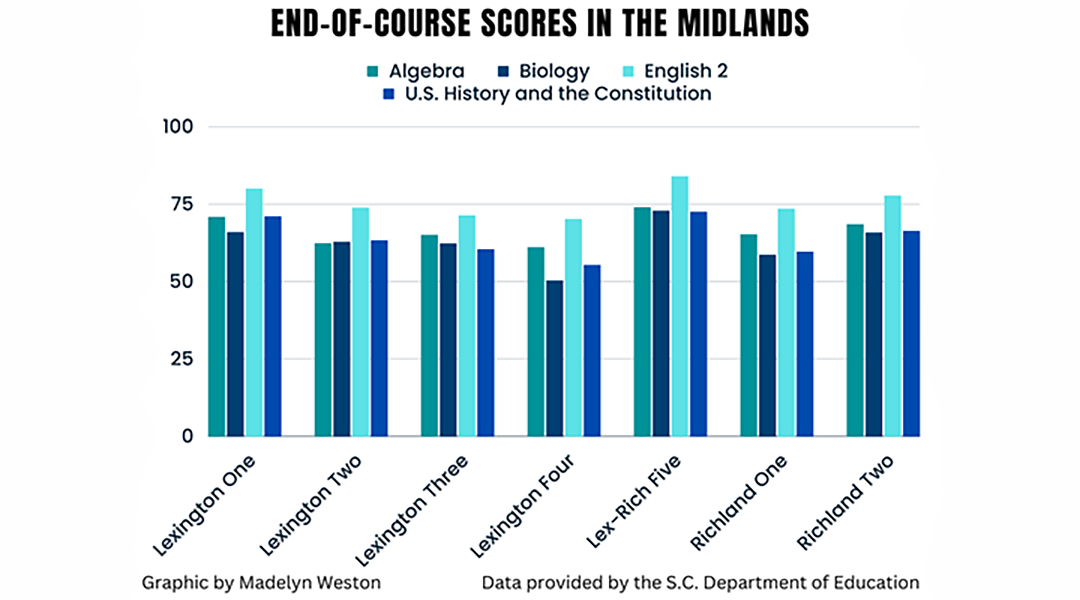The learning gap from virtual learning is still affecting Midlands students, but annual English scores are standing their ground.
Students are more familiar with English content because reading and writing comprehension is a life skill that students use in all subjects, educators said. Meanwhile, since mathematics builds on previous learning, students who didn’t understand the concepts during virtual learning continue to struggle now.
“South Carolina students have seen marked gains in (English Language Arts) compared with pre-pandemic data and continue to struggle with math,” said state Superintendent of Education Ellen Weaver in a statement on the department’s website.
The scores, released by the education department Sept. 18, show English scores increasing, but students are failing the U.S history and the constitution exam at a concerning rate, Weaver said.
Midlands districts reflected the statewide improvements in English. The content of English classes is somewhat consistent as students progress through school, said Tina McCaskill, chief of academics at Lexington-Richland School District Five.
“The rigor of it gets a little harder along and along, but the content stays fairly consistent,” McCaskill said. “So maybe that’s a part of feeling comfortable.”
For the first time in recent history, at least half of students in each grade of elementary and middle schools reached proficiency in English.
“Reading is the foundation of all other learning,” Weaver said in response to similar strong English scores on the S.C. Palmetto Assessment of State Standards tests.
That’s why schools focus on writing and analysis skills, educators say.
“One of the things that we try to do with the literacy parts, we try to put those concepts into other courses,” said Dr. Craig Witherspoon, superintendent of Columbia’s Richland County School District One. “If you’re writing papers in all of your subjects, then that makes you a better writer in general.”
Relating biology, algebra and history to other subjects can be more difficult, Witherspoon said.
The mean scores for Richland School District One in algebra and English 2 improved by about 2 percentage points since last year. Students continue to struggle in biology, with 59.40% scoring an F, and 57.39% failing the history exam.
There was a learning loss when students moved to virtual learning, so Richland One is working to fill those gaps and move students forward, Witherspoon said.
“There’s still been an impact,” Witherspoon said. “A lot of these skills, even to talk about math or what have you, they build upon each other.”
Richland One students aren’t the only ones struggling in biology and history.
Sixty percent of students in Lexington School District Four failed the history exam, 75.49% scored an F in biology and almost half failed the algebra exam.
The good news is that English 2 scores in Lexington Four improved by two percentage points, pushing the mean score to a C.
The time spent on course content is chosen by how concepts are weighted on exams, Witherspoon said. Richland One analyzes the scores to see where the support is needed to make that determination.
One challenge educators may face is if students are below grade level, Lex-Rich Five’s McCaskill said. It’s also difficult to help them catch up while maintaining the standard for the next year of learning.
“We have to learn how to truly engage the students in their own learning,” she said. “Our teachers are feeling much more confident.”
The atmosphere and environment are also better than during the pandemic, McCaskill said.
Lex-Rich Five had a 2- to 3-percentage-point increase in all subjects, which McCaskill attributes to good communication between administrators and teachers. The fail rate in algebra was reduced by 8 percentage points.
“When I talk to teachers, and I talk with our coordinators that work with teachers, the focus on the rigor of the standard was huge,” McCaskill said. “Our administrators are supporting and coaching and ensuring that the strategies are actually taking place.”
Counselors work with students to reduce anxiety because the tests, called End-of-Course exams, are high-stakes tests that count for 20% of a student’s final grade, she said.
“They have mentors, they have an adult that they can talk to if they’re having anxiety,” McCaskill said. “They have places they can go to just kind of take a breath.”
And students have focused tutoring time to teach them test-taking strategies.
“All students aren’t good test takers, they get that anxiety,” Witherspoon said. “And that’s why you do the practice tests and there are other strategies of test taking so that students get better at that.”
Students taking the history EOC were tested on a new standard this year, McCaskill said.
A memo from the education department shows that tests also changed for English.
The state has not released sample items that include the updated standards for the history end-of-course exam, which was first administered in 2023. McCaskill thinks that may account for the lower scores in history in many South Carolina districts.
Weaver said in a statement that she plans to focus more on civics education.
“I’m particularly concerned that nearly 40% of students received a failing score on the U.S. History exam,” Weaver said. “Our future depends upon citizens with knowledge deeply rooted in our shared story and America’s exceptional founding ideals.”
The statewide 2023 biology score fail rate is slightly higher than history, which has made an improvement since last year, when 43.55% of students scored an F.
Now it’s 39.14% statewide, and Midlands schools are reducing their fail rates.
Lexington School District One’s score in history improved by 7 percentage points, reaching a C average and reducing its fail rate to 31.35% from 45.48%. The district also gained a few percentage points in its algebra and English 2 scores.
Lexington School District Two scores increased 2- to 3-percentage points in algebra, biology and history, while English 2 performance remained similar to that from 2022. Its fail rate in history dropped from 52.45% to 44.71%.
Lexington School District Three reduced its fail rate for history by 11%, lowering it to 51.41%, and reaching a C average. Its score also grew 4 percentage points in algebra. But the fail rate for biology increased from 31.43% to 48.37%.
The fail rate for history in Richland School District Two decreased to 40.87% from 49.74%. Average scores for all other subjects increased a percentage point.
End-of-course exams are continuously changing, Witherspoon said.
It’s hard to compare recent test scores to those from six years ago because standards have changed, Witherspoon said. There’s no one assessment that shows everything about a student or school.
“It’s not the only way to demonstrate mastery,” Witherspoon said. “We all have different skills sets and talents.”
The testing environment has already been shifting towards more critical thinking skills than fact memorization, McCaskill said.
“Everything’s really looking at a lot more of soft skills and collaboration and process skills versus just kind of regurgitation of facts,” she said. “It really is more about application.”
Educators are constantly looking ahead to see what knowledge their students will need in four to five years, McCaskill said.




